
Euphorbia is a very large and diverse genus of flowering plants, commonly called spurge, in the family Euphorbiaceae. "Euphorbia" is sometimes used in ordinary English to collectively refer to all members of Euphorbiaceae, not just to members of the genus.
Sycamore is a name which has been applied to several types of trees, but with somewhat similar leaf forms. The name derives from the ancient Greek συκόμορος (sūkomoros) meaning "fig-mulberry".
Stinkwood, german Stinkholz, french Bois Puant, is the common name for a number of trees or shrubs which have wood or plant parts with an unpleasant odour, including:

The Living Desert Zoo and Gardens, formerly the Living Desert Museum, is a non-profit zoo and desert botanical garden located in Palm Desert, Riverside County, California, United States. The Living Desert is home to over 500 animals representing over 150 species and welcomes over 500,000 visitors annually. Situated in the Sonoran Desert of the Coachella Valley and Santa Rosa Mountains foothills near Palm Springs, California, The Living Desert is set on 1,200 acres, with 80 developed as zoo and gardens.
Rain tree is a common name for several plants and may refer to:
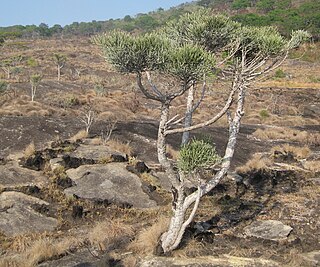
Euphorbia tirucalli is a tree native to Africa that grows in semi-arid tropical climates. A hydrocarbon plant, it produces a poisonous latex that can cause temporary blindness.
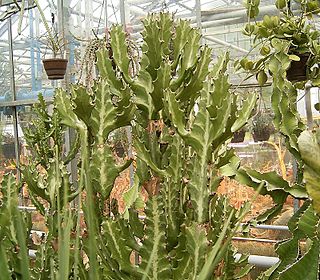
Euphorbia lactea is a species of spurge native to tropical Asia, mainly in India.
Milkweed, Asclepias, is a genus of herbaceous, perennial, flowering plants named for their milky latex sap.
Leafy spurge may refer to several species of plant in the genus Euphorbia, including:
Euphorbia cussonioides is a species of plant in the family Euphorbiaceae. It is endemic to Kenya. It goes by the common name the Candelabra tree.
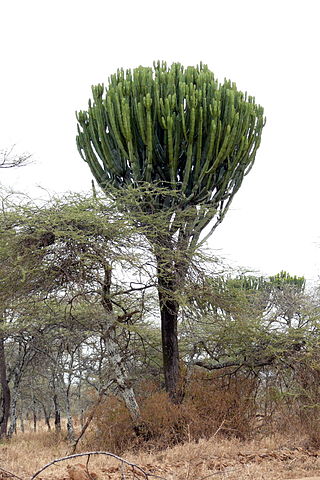
Euphorbia candelabrum is a succulent species of plant in the family Euphorbiaceae, one of several plants commonly known as candelabra tree. It is endemic to the Horn of Africa and eastern Africa along the East African Rift system. It is known in Ethiopia by its Amharic name, qwolqwal, or its Oromo name, adaamii. It is closely related to three other species of Euphorbia: Euphorbia ingens in the dry regions of southern Africa, Euphorbia conspicua from western Angola, and Euphorbia abyssinica, which is native to countries including Sudan, Eritrea, Djibouti, Ethiopia and Somalia.
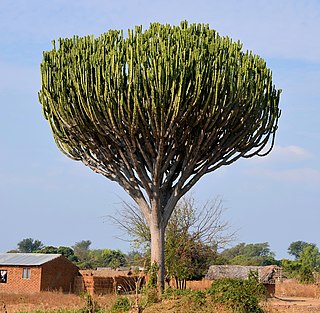
Euphorbia ingens is a species of flowering plant in the family Euphorbiaceae. It is native to dry areas of southern Africa. It is popularly known as the candelabra tree or naboom. Its milky latex can be extremely poisonous and is a dangerous irritant.
Palustris is a Latin word meaning "swampy" or "marshy", and may refer to:

African rosewood is a common name for several plants and may refer to:

Euphorbia cooperi is a flowering plant in the Euphorbiaceae family. It is commonly called Transvaal candelabra tree or bushveld candelabra euphorbia, and is found in South Africa.
Amendoim bravo is a common name for several plants and may refer to:
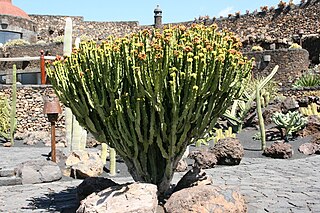
Euphorbia abyssinica, commonly known as the desert candle or candelabra spurge, is a species of plant in the family Euphorbiaceae. E. abyssinica is endemic to Ethiopia, Somalia, Sudan and Eritrea. It was first described in 1791, by the German botanist Johann Friedrich Gmelin. In its native habitat, it can grow up to 10 m (33 ft) tall. The woody stem is used for firewood and as timber in roofing, furniture and other items, and the sap is used in traditional medicine. It is also cultivated as an ornamental house plant.
Yellow-spotted tree frog is a common name for several frogs and may refer to:
Pencil cactus may refer to:

Euphorbia regis-jubae is a species of flowering plant in the family Euphorbiaceae, native to the eastern Canary Islands, western Morocco, north-western Western Sahara. In Spanish, it is known as tabaiba morisca. It has often been confused with Euphorbia lamarckii. The specific epithet regis-jubae, meaning 'King Juba's euphorbia' honours the king's contributions to natural history and his role in bringing the genus to notice. The palm tree genus Jubaea is also named after Juba.
This page is based on this
Wikipedia article Text is available under the
CC BY-SA 4.0 license; additional terms may apply.
Images, videos and audio are available under their respective licenses.









